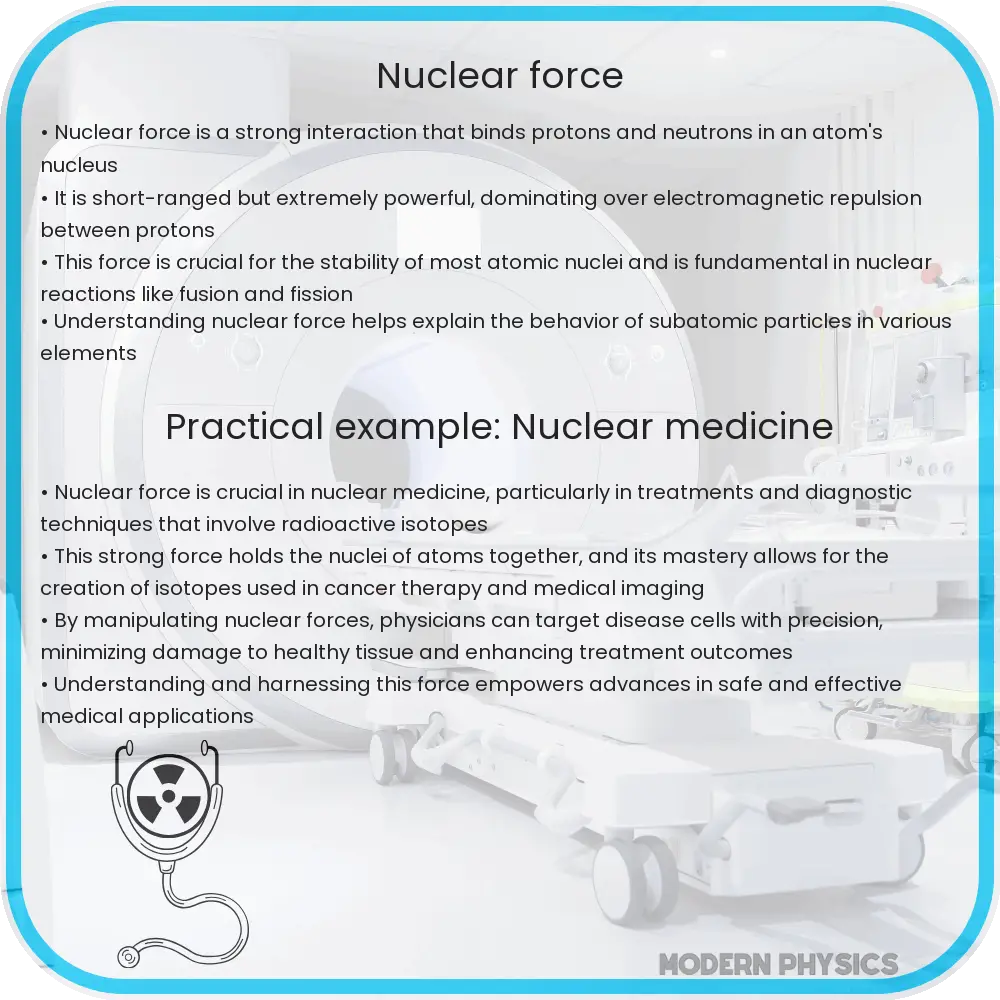An in-depth examination of the nuclear force, explaining its strength, range, and key role in atomic stability and element synthesis.

Nuclear Force: An Overview
The nuclear force, also known as the strong nuclear force or strong force, is one of the four fundamental forces of nature, alongside gravity, electromagnetism, and the weak nuclear force. It plays a crucial role in the stability and structure of matter at the sub-atomic level. This force is responsible for binding protons and neutrons (nucleons) together in the nucleus of an atom, ultimately allowing atoms to exist and matter to form.
Characteristics of Nuclear Force
The nuclear force has several key characteristics that distinguish it from other fundamental forces:
- Strength: It is the strongest of the four fundamental forces. Despite being approximately 137 times stronger than electromagnetism, its effects are not as apparent because it operates over a very short range.
- Range: The nuclear force acts over a very short range, typically about the size of an atomic nucleus (approximately 1 to 2.5 femtometers, or 1 to 2.5 x 10-15 meters). Beyond this range, its influence diminishes rapidly and becomes negligible when compared to other forces.
- Charge Independence: Interestingly, the nuclear force acts nearly the same way between all combinations of protons and neutrons, whether it is proton-proton, neutron-neutron, or neutron-proton interactions. This property is known as charge independence.
- Spin Dependence: The force can vary depending on the alignment of the nucleons’ spins. This spin dependence is crucial for the formation of different nuclear isotopes and their properties.
- Saturation: The nuclear force does not increase indefinitely as more nucleons are added to a nucleus. Instead, it “saturates,” meaning that each nucleon primarily interacts with only its closest neighbours and not with all nucleons in the nucleus.
The Role of the Nuclear Force in Nature
The nuclear force is vital for the existence of atoms and consequently, for the formation of matter in the universe. Without this force, protons in an atomic nucleus would repel each other due to their positive electric charge, leading to the disintegration of the nucleus. Below, we explore some of the critical roles of the nuclear force:
- Stability of Atoms: By effectively binding protons and neutrons together in the nucleus, the nuclear force overcomes the electromagnetic repulsion between protons, thereby lending stability to atoms.
- Synthesis of Elements: In stellar environments, the nuclear force contributes to the fusion processes that produce heavier elements from hydrogen and helium, a process central to star life cycles and the cosmos’ chemical diversity.
- Energy Production: The strong force also plays a role in nuclear power generation, where nuclear reactions (fission or fusion) release large amounts of energy, primarily due to the manipulation of forces within the nucleus.
Understanding Nuclear Force Through Quantum Chromodynamics (QCD)
Quantum chromodynamics (QCD) is the theory that describes the behavior of the strong nuclear force within the realm of particle physics. It explains how the force operates between quarks, the smaller constituents of protons and neutrons, through the exchange of particles known as gluons. These interactions ensure the confinement of quarks within protons and neutrons, a phenomenon that prevents them from being isolated in nature.
- Color Charge: In QCD, ‘color’ is the equivalent of electric charge in electromagnetism, but it comes in three types — red, green, and blue. Gluons, which mediate the strong force, carry this color charge and are responsible for the strong interaction between quarks.
- Gluon Exchange: The continuous exchange of gluons among quarks within a nucleon and between nucleons holds these particles together in a compact nucleus, despite the vast empty spaces between them.
- Confinement: QCD predicts that quarks are always confined within composite particles (like protons and neutrons), explaining why we never observe them in isolation.
Practical Applications of Nuclear Force
The principles of nuclear force have implications not only in theoretical physics but also in practical applications that affect everyday life:
- Medical Imaging and Treatments: Techniques such as positron emission tomography (PET) scans use nuclear physics principles to help diagnose and treat illnesses.
- Nuclear Medicine: Radioactive isotopes are used for various therapies, including cancer treatment, where they target abnormal cells without extensive surgical procedures.
- Energy Security: Nuclear energy, derived from controlled nuclear reactions, provides a substantial portion of the world’s electricity, offering a stable and high-density alternative to fossil fuels.
Conclusion
The nuclear force is a fundamental cornerstone of both the microscopic and the cosmic scale realms. Its overwhelming strength, confined to a minuscule range, underscores its unique role in the universe. From binding atoms to powering stars, the influence of the nuclear force is pervasive and profound. Understanding this force not only illuminates the intricacies of atomic structure but also unveils numerous applications that harness its power for the advancement of technology and medicine. As we continue to delve deeper into the realms of quantum chromodynamics and nuclear physics, our grasp of the universe’s fundamental workings will inevitably become more refined, opening new avenues for scientific and technological progress.
